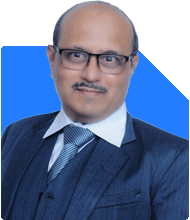How can a 33-year-old woman with a Rs.2 lakh salary, Rs.37 lakh home loan, and Rs.91,500 monthly expenses build her investment portfolio for retirement at 50?
Ramalingam Kalirajan |10893 Answers |Ask -Follow
Mutual Funds, Financial Planning Expert - Answered on Aug 08, 2024
He has an MBA in finance from the University of Madras and is a certified financial planner.
He is the director and chief financial planner at Holistic Investment, a Chennai-based firm that offers financial planning and wealth management advice.... more

I am 33 years old female with a monthly salary of 2 lakhs. I have a 6 year old son. I have a home loan of 37 lakhs. Monthly expenses 31500 of home loan emi , house expenses 60000 . I have no emergency fund. I have to start investing in mutual fund and stocks . Please help in guiding me for the same to build the portfolio within next 15 to 20 years. I have to retire at 50
Current Financial Situation
Age: 33 years
Monthly Salary: Rs 2 lakhs
Home Loan: Rs 37 lakhs with a monthly EMI of Rs 31,500
Monthly Household Expenses: Rs 60,000
No Emergency Fund: This is a critical aspect to address
Investment Goals: Building a portfolio for retirement and starting investments in mutual funds and stocks
Building an Emergency Fund
Before you start investing, it's crucial to build an emergency fund.
Fund Size: Aim for 6-12 months of expenses
Monthly Savings: Set aside Rs 30,000-40,000 monthly until you reach this goal
Savings Account: Use a high-interest savings account or a liquid mutual fund
Home Loan Management
Your home loan EMI is Rs 31,500, a significant portion of your monthly expenses.
Prepayment: Consider making lump sum prepayments when possible to reduce the loan tenure and interest
Interest Rates: Regularly review and switch to lower interest rates if available
Investment Strategy for Mutual Funds
Diversified Portfolio
Creating a diversified portfolio will help balance risk and returns.
Large-Cap Funds: These funds invest in large, established companies. They offer stability and steady growth.
Mid-Cap Funds: These funds invest in medium-sized companies with high growth potential. They are moderately risky.
Multi-Cap Funds: These funds invest across large, mid, and small-cap stocks, providing diversified growth.
Equity-Linked Savings Scheme (ELSS): These funds offer tax benefits under Section 80C and are good for long-term growth.
SIPs for Consistent Investing
Start a Systematic Investment Plan (SIP) to invest regularly.
Monthly SIP Amount: Aim to invest Rs 50,000-60,000 monthly across different funds
Automate Investments: Set up automatic transfers to ensure consistent investing
Active Fund Management
Actively managed funds often outperform index funds.
Fund Manager’s Track Record: Choose funds with experienced managers who have a good performance history
Risk-Adjusted Returns: Evaluate funds based on risk-adjusted returns
Stock Investments
Investing in stocks can provide higher returns but comes with higher risk.
Building a Stock Portfolio
Blue-Chip Stocks: Invest in well-established companies with a strong track record
Growth Stocks: Invest in companies with high growth potential
Diversification: Spread investments across various sectors to reduce risk
Regular Monitoring
Review Performance: Regularly monitor your stock portfolio
Adjust Holdings: Make adjustments based on market conditions and company performance
Insurance Coverage
Ensuring adequate insurance coverage is crucial for financial security.
Health Insurance
Coverage Amount: Ensure you have a health insurance policy with adequate coverage
Family Floater: Consider a family floater plan for comprehensive coverage
Life Insurance
Term Plan: Opt for a term plan to provide financial security for your family
Coverage Amount: The sum assured should be at least 10-15 times your annual income
Retirement Planning
Setting Retirement Goals
Monthly Income Requirement: Estimate the monthly income you will need post-retirement
Inflation Adjustment: Factor in inflation to ensure your savings last throughout retirement
Investment for Retirement
Long-Term Equity Investments: Continue investing in equity mutual funds for long-term growth
Debt Funds: Gradually shift to debt funds as you approach retirement for stability
Regular Review and Adjustment
Annual Review: Review your financial plan annually
Adjust Investments: Make necessary adjustments based on changes in income, expenses, and financial goals
Final Insights
By building an emergency fund, managing your home loan, and strategically investing in mutual funds and stocks, you can achieve your retirement goal. Diversify your investments, ensure adequate insurance coverage, and regularly review your financial plan. This comprehensive approach will help you build a robust portfolio over the next 15-20 years.
Best Regards,
K. Ramalingam, MBA, CFP,
Chief Financial Planner,
www.holisticinvestment.in
You may like to see similar questions and answers below
Ramalingam Kalirajan |10893 Answers |Ask -Follow
Mutual Funds, Financial Planning Expert - Answered on Aug 12, 2024
Ramalingam Kalirajan |10893 Answers |Ask -Follow
Mutual Funds, Financial Planning Expert - Answered on Aug 20, 2024
Ramalingam Kalirajan |10893 Answers |Ask -Follow
Mutual Funds, Financial Planning Expert - Answered on Jan 13, 2025
Reetika Sharma |425 Answers |Ask -Follow
Financial Planner, MF and Insurance Expert - Answered on Sep 17, 2025
Nitin Narkhede |113 Answers |Ask -Follow
MF, PF Expert - Answered on Dec 15, 2025
Nitin Narkhede |113 Answers |Ask -Follow
MF, PF Expert - Answered on Dec 15, 2025
Ramalingam Kalirajan |10893 Answers |Ask -Follow
Mutual Funds, Financial Planning Expert - Answered on Dec 15, 2025
Ramalingam Kalirajan |10893 Answers |Ask -Follow
Mutual Funds, Financial Planning Expert - Answered on Dec 15, 2025
Radheshyam Zanwar |6746 Answers |Ask -Follow
MHT-CET, IIT-JEE, NEET-UG Expert - Answered on Dec 15, 2025
Ramalingam Kalirajan |10893 Answers |Ask -Follow
Mutual Funds, Financial Planning Expert - Answered on Dec 15, 2025
Ramalingam Kalirajan |10893 Answers |Ask -Follow
Mutual Funds, Financial Planning Expert - Answered on Dec 15, 2025
Ramalingam Kalirajan |10893 Answers |Ask -Follow
Mutual Funds, Financial Planning Expert - Answered on Dec 15, 2025
Samraat Jadhav |2508 Answers |Ask -Follow
Stock Market Expert - Answered on Dec 15, 2025
Ramalingam Kalirajan |10893 Answers |Ask -Follow
Mutual Funds, Financial Planning Expert - Answered on Dec 15, 2025










.jpg)













